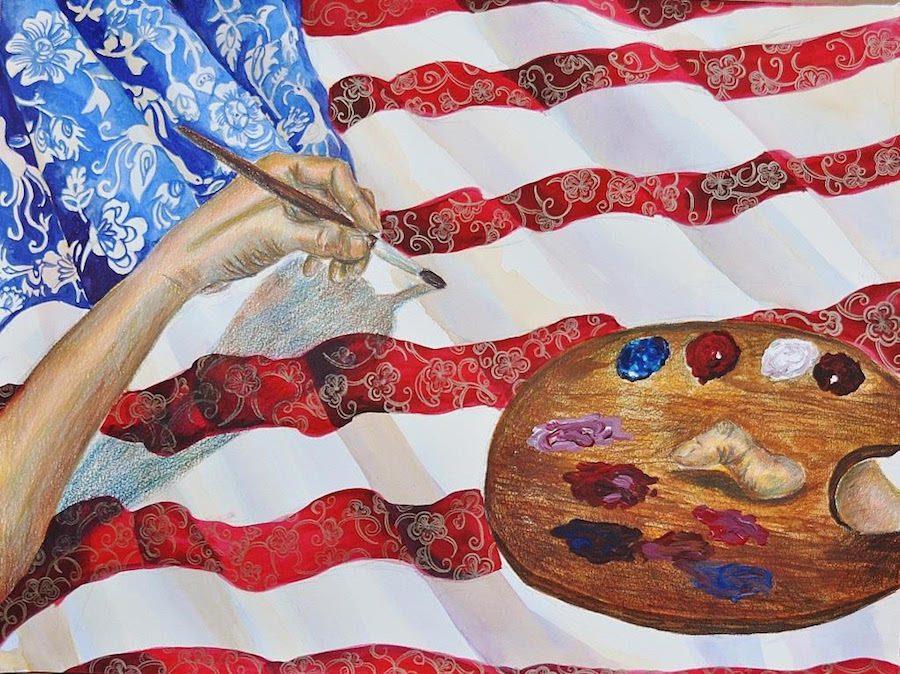Seniors finalize AP art assignments
Seniors Danika Lara, Samantha Tucker work on their current art work during their third period AP art class.
February 10, 2017
What makes AP Art different from all other AP classes? Seniors Cassidee Lowry and Kimberly Lin provide an inside look on what AP Art and the AP Art test is truly like at CHS.
Being a unique class, it has unique assignments and tests.
“We have to make 24 [art] pieces for the whole semester, and we have to do 6 over the summer,” senior Kimberly Lin said. “Throughout the semester there is a piece due every two weeks.”
A lot of the class revolves around preparation of their breath and concentration pieces.
“There are two sections of the 24 pieces,” senior Cassidee Lowry said. “One is breath, which is random stuff you like to do to show your skills and different aspects of art. The second half is your concentration and that’s a main idea. My concentration is emphasis of the eyes.”
Unlike other AP classes, the AP test at the end of the year does not consist of a multiple-choice exam and essay questions.
“You have to do a presentation [for the AP test],” Lin said. “You have to make a PowerPoint and explain all your pieces. You show the judges all your pieces first and they have to guess what your concentration idea is, and if they don’t guess right, you get a lower score. There are 2 questions that you have to write a short paragraph for like ‘What’s your concentration idea?’ and ‘How do you show your idea within your pieces?’”
The unique-style class also allows students to be more independent and inventive. It is different from the lessons and activities associated with a traditional class.
“You’re more creative,” Lowry said. “You’re more connected to people in the class. You have more of a free-range; you’re not by rubric. You get to learn what you want to learn, and you get to do what you want to do, and you get the steps that you want to take.”
Along with more independence, the students also master teamwork and synergy, especially while preparing for the AP test.
“When we were doing our [AP test] presentations for midterms, we were reviewing each other’s work and wrote opinions about each other,” Lin said. It’s not just the teacher telling you what to change, it’s the whole class giving opinions. You’re more connected to your classmates because you’re basically like teammates.”
Students are able to develop certain skills in each different level of art they take from Art I to AP Art.
“Art II and Art III just builds up your skills,” Lin said. “You don’t get to choose what you want to do, the teacher tells you what to do. If you don’t have the basic skills, you’re just going to be really stressed in AP Art because no one is telling you how to do this or how to do that. You can work on your own and manage your time.”
The students have recognized the great opportunity they have had to learn from an experienced teacher. She focuses on ways to get the kids out of their comfort zone to develop and perfect their skills.
“[The teacher] teaches you a lot of good ways to not use the left side of your brain,” Lowry said. “She wants you to use the right because that’s what an artist really uses. A true artist basically uses the right side of their brain. You see it as it is. We’re lucky to have a teacher that’s gone to multiple colleges because she sees what every college expects.”
Taking art classes over the years has paid off. With many years of experience comes many lessons learned, making the class very valuable and beneficial.
“You have to learn patience because if you’re not patient, you’ll just get so mad at yourself and you’ll want to give up,” Lowry said. “There’s those days where you just don’t even want to pick up the pencil.”
Each art piece takes a lot of time to complete, so patience is key. And, because the art pieces are finished outside of class, students are provided their own art sets and supplies they can take home to complete work.
“It’s not just class time,” Lin said. “You have to spend 10 hours at home to finish a piece. The time that we work the most is not at school, it’s at home. You only have 2 hours at school, and it’s not enough.”
All the work and effort is worth it in the end to the artists though.
“Patience is the most important thing,” Lowry said. “You have to see the values of the art. It makes you stronger too.”

















